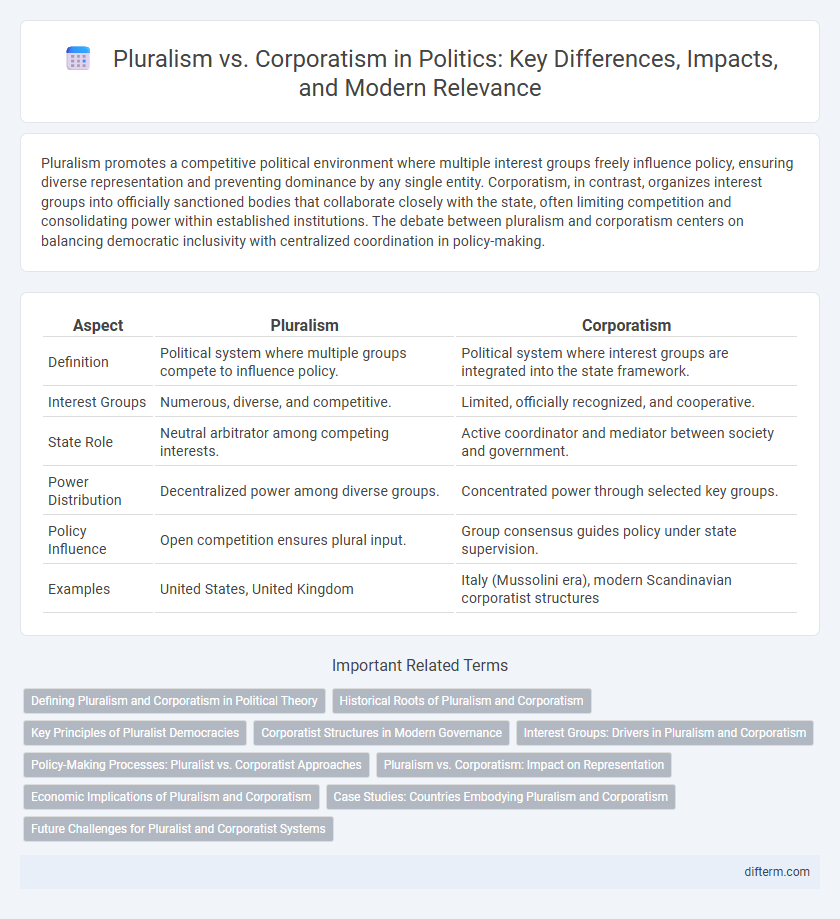Pluralism promotes a competitive political environment where multiple interest groups freely influence policy, ensuring diverse representation and preventing dominance by any single entity. Corporatism, in contrast, organizes interest groups into officially sanctioned bodies that collaborate closely with the state, often limiting competition and consolidating power within established institutions. The debate between pluralism and corporatism centers on balancing democratic inclusivity with centralized coordination in policy-making.
Table of Comparison
| Aspect | Pluralism | Corporatism |
|---|---|---|
| Definition | Political system where multiple groups compete to influence policy. | Political system where interest groups are integrated into the state framework. |
| Interest Groups | Numerous, diverse, and competitive. | Limited, officially recognized, and cooperative. |
| State Role | Neutral arbitrator among competing interests. | Active coordinator and mediator between society and government. |
| Power Distribution | Decentralized power among diverse groups. | Concentrated power through selected key groups. |
| Policy Influence | Open competition ensures plural input. | Group consensus guides policy under state supervision. |
| Examples | United States, United Kingdom | Italy (Mussolini era), modern Scandinavian corporatist structures |
Defining Pluralism and Corporatism in Political Theory
Pluralism in political theory emphasizes the dispersion of power among diverse interest groups, ensuring no single entity dominates policymaking, thereby fostering democratic representation and competition. Corporatism, by contrast, involves structured collaboration between the state and major interest groups such as labor unions and business associations, aiming for coordinated policy decisions that reflect collective interests. Both models propose distinct mechanisms for managing political influence and power distribution within governance systems.
Historical Roots of Pluralism and Corporatism
Pluralism originated in early 20th-century liberal democracies as a response to authoritarianism, emphasizing a decentralized distribution of power among diverse interest groups. Corporatism traces back to medieval Europe, where economic and social organizations, such as guilds and estates, collaborated with the state to manage societal functions. These historical roots underscore pluralism's focus on competition among autonomous groups versus corporatism's integration of interest groups within state structures.
Key Principles of Pluralist Democracies
Pluralist democracies emphasize the dispersion of power among diverse and competing interest groups, ensuring no single entity dominates the political process. Key principles include open access to political participation, protection of minority rights, and institutional mechanisms that encourage negotiation and compromise among multiple stakeholders. This framework supports a dynamic political environment where policy outcomes result from the interaction of various independent groups representing different interests.
Corporatist Structures in Modern Governance
Corporatist structures in modern governance involve the integration of interest groups, such as labor unions, business associations, and professional organizations, into formal policy-making processes. This system contrasts with pluralism by emphasizing coordinated collaboration between the state and key organized sectors to achieve consensus and stability. Countries like Italy and Brazil demonstrate corporatist governance models where institutionalized cooperation aims to balance competing interests and streamline decision-making.
Interest Groups: Drivers in Pluralism and Corporatism
Interest groups play a pivotal role as drivers in both pluralism and corporatism, shaping policy outcomes through their organization and influence. In pluralism, diverse and competing interest groups freely engage in the political process, ensuring multiple voices and decentralized power, whereas in corporatism, selected interest groups, often representative of major economic sectors, are formally integrated into policymaking, creating structured collaboration between the state and these entities. The contrasting mechanisms of interest group participation highlight the differences in how political systems balance societal demands and state control.
Policy-Making Processes: Pluralist vs. Corporatist Approaches
Pluralist policy-making processes emphasize diverse interest groups competing openly to influence government decisions, ensuring a decentralized distribution of power and responsiveness to a wide range of social demands. Corporatist approaches centralize policy-making through structured negotiations among government, business, and labor representatives, promoting coordinated consensus and reducing conflict. This institutional integration in corporatism often leads to more stable but less flexible policy outcomes compared to the dynamic competition characteristic of pluralism.
Pluralism vs. Corporatism: Impact on Representation
Pluralism promotes diverse interest groups competing freely to influence policy, enhancing broad representation across social sectors. Corporatism involves structured collaboration between the state and select interest groups, often restricting representation to organized, institutionalized bodies. This distinction affects democratic inclusivity, with pluralism fostering wider citizen participation while corporatism may limit influence to elite or officially recognized groups.
Economic Implications of Pluralism and Corporatism
Pluralism promotes economic competition and diversity by enabling multiple interest groups to influence policy, fostering innovation and market responsiveness. Corporatism centralizes economic decision-making among key organized groups such as labor, business, and government, potentially leading to coordinated wage policies and industrial relations that stabilize the economy. The economic implications of pluralism include enhanced market efficiency and entrepreneurial activity, whereas corporatism can result in more predictable economic planning but risks reduced competition and potential inefficiencies due to negotiation among a limited set of actors.
Case Studies: Countries Embodying Pluralism and Corporatism
The United States exemplifies pluralism with its diverse interest groups and competitive political environment fostering broad participation and influence. Sweden represents corporatism through its institutionalized collaboration between government, labor unions, and employers, ensuring negotiated policy outcomes. These case studies highlight how pluralism encourages decentralized power while corporatism emphasizes structured cooperation among key societal actors.
Future Challenges for Pluralist and Corporatist Systems
Pluralist systems face future challenges in managing increased political fragmentation and ensuring broad representation amid growing societal diversity. Corporatist systems risk diminished relevance as global economic integration and technological advancements shift power away from traditional interest groups toward more fluid networks. Both models must adapt to digital transformation and evolving citizen engagement patterns to sustain effective governance and policy-making.
pluralism vs corporatism Infographic

 difterm.com
difterm.com